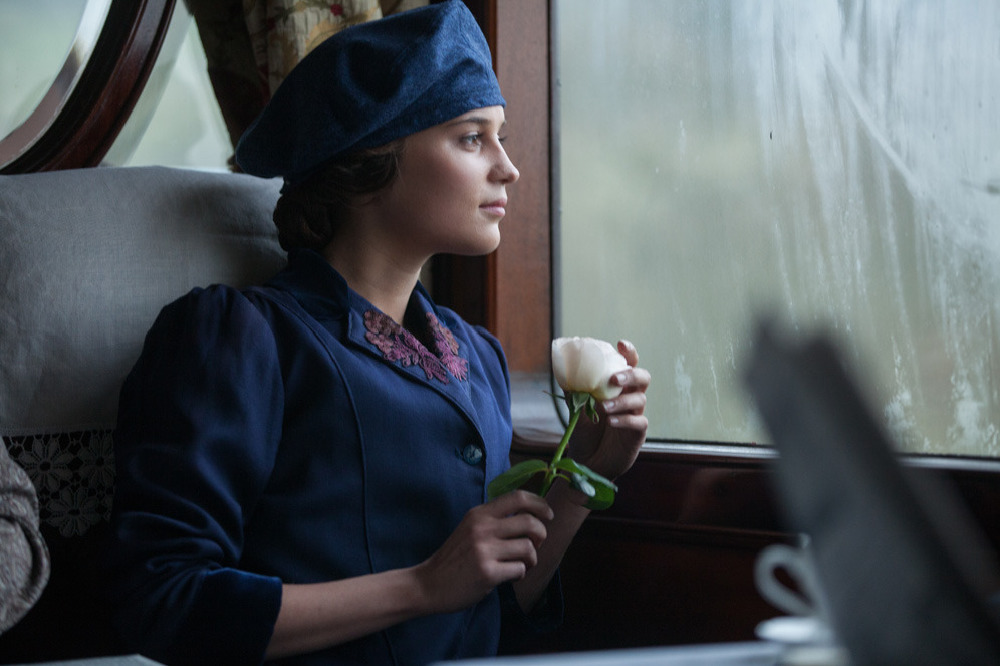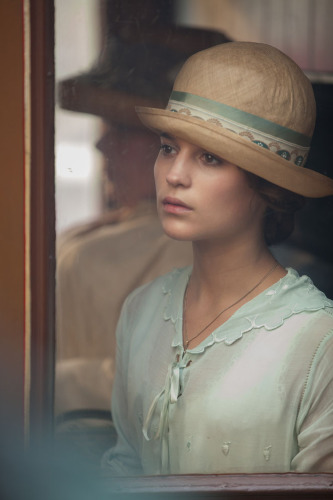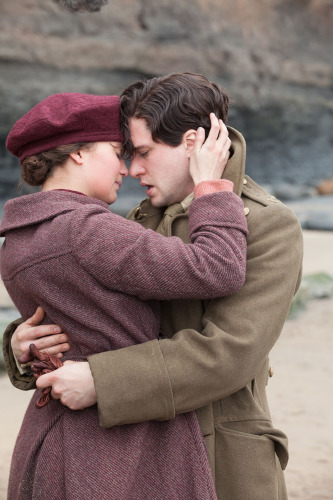
Testament of Youth
Consolata Boyle is one of the most sought after costume designers having worked on the likes of Philomena, Angela’s Ashes, and The Iron Lady during her career. Now she is back, having worked on Testament of Youth.
Testament of Youth is based on the World War I memoir of Vera Brittain and saw Boyle and her team have to create costumes that were pre-war, wartime, and post-war as this incredible book was brought to the big screen for the first time.
We caught up with the costume designer to chat about the new project, working with the likes of James Kent, Alicia Vikander, and Kit Harington and what lies ahead.
- Testament of Youth has hit the big screen today for which you have designed the costumes, so how did you get involved with the project?
I was sent the script and I read it and absolutely loved it. I thought that it was a very important project to do at this time, and it resonated with me in a very big way. Then I went and the director and the producer, and I liked Jamie and Rosie very much and the feeling around the project was something that I really tuned into.
I really understood how James wanted to do it and the cast that was starting to gather around it was exiting. Everything seemed to bode so well for the project. I loved the writing, I loved the script, and I was very glad to accept the offer to design the costumes. So, that is really how that happened.
- The movie is based on the memoir of Vera Brittain, so were you familiar with the book and the story? And really drew you to work on this project?
I had read the book and then I went on to read the diaries - which are equally important and really revealing. The book was written quite a few years after the terrible events of the war but the diaries are very close to what her thoughts were at the time - I found her diaries to be very very valuable. My team and I did a lot of research around the period, including the military end and the nursing end as well as the period of her life before and after World War I.
- James Kent is in the director's chair for the film, so what was it that he wanted from the costumes when you sat down and discussed the project for the first time?
His vision for his film and the story… it is very much Vera’s point of view and everything really is seen though her eyes and it is very much her journey of this young, impetuous, highly brilliant, ambitious, and strong-willed young woman in 1914 before the war started. She had ambitions to go to Oxford and she wanted to break out of the confines of the expectations that were around a young woman at the time - that was to marry and marry well.
She was ambitious for herself, she was ambitious to do things, see things and learn things, and she wanted to go to Oxford: she had to argue with her father about that. However, it was an argument that she finally won. During the years prior to all of the experience she had during the war, she was a young woman who loved beauty and clothes: that delicate part of her was very important as she noticed things and made notes in her diary about frocks and outfits that she wore and what she matched them with - it was beautifully revealing.
And yet, it was combined with this ambition to do, see, learn, travel and stretch herself: those two things are part of the tapestry of who she was. Therefore, James was really keen to show that. Through the experiences that she goes through with the devastation of the loss of those who are closest to her was very much… she made it clear in her diaries that she wanted to make sure that the young men who were closest to her - her brother, her fiancé and her good friend Victor - would always be remembered.
The horror of the experiences that she was exposed to and working as a VAD nurse on the front line, means that when she goes back to Oxford she was a very different person. The war had refined her, chastened her, and made her stronger in a way. She comes out not broken - deeply changed - but strong. James and I wanted to reflect the simplicity of how she looked and the lack of the importance of exterior after the war.
That is very much the arc of her journey, were she becomes very politicised and a pacifist. Through all the experiences that she had, she becomes a feminist and a pacifist and has that amazing final speech at the end of the film. All of that needed to be reflected in the costumes. From a fashion point of view, the war refined women’s clothes; they were wearing uniforms and were part of the whole war effort and that had an effect on fashion at the time.
Fashion became more tailored, colours become more sombre, fabrics simpler with less decoration - there was a physical and factual response to the war shown in the fashion after the war. Everything became much simpler, and you can really see that very clearly in how fashion reflects social change and we reflected that in the film.

- Can you talk about the first steps that you take once you have a script or source material and you know what the director is looking for? How do you move forward and start the work?
This is personal and every designer does approach the work differently, but the most important thing for me is the script. The script is completely taken apart and the characters are analysed so we know where they have come from, where they are going, what they are experiencing, and what their backstory is - so there is a vast amount of research.
With Testament of Youth we are dealing with a person who actually lived, so all of that research has to start - that is actually a wonderful part of the process that I really enjoy. You research the actual people, the actual events, and then the social history around those people and the world at that time, and their intimate place in time. My role is to put clothes on them that reflect what is happening, and all that combines to build up a tapestry of that character, how they could come in and how they would express themselves in clothes - both for the men and the women.
Then there were the whole volunteer nurses of that period and the military needs to be completely accurate - there can’t be a false note amongst anything military. You take all that research, and in some ways you have to leave it behind and not allow it to completely confine what you do as you are telling a story - this is not a documentary - it is a story that is based on fact, but we have to make is so that we can tell the story as true a way as we can and reflecting the overall vision of the film.
- What were the major challenges that you faced, as you had to design clothes that were pre-war, wartime, and post-war and reflect everything that was socially correct about the time? That is a huge amount of pressure.
Yes it was. It was such a wide spread. However, that wasn’t a problem as it just meant that you had to hit the ground running and move as fast and spread out as fast as you could. Obviously, there was a lot of existing information and you had to find it, refine it, and get through all of this information to discover what it is you are actually looking for. You had to not allow it to cripple you and be able to leave stuff aside and decide what to leave out: in a way, what you leave out is almost as important as what you decide to run with.
You have to make the decisions of what is important and what is not important from a story point of view and a character point of view. Through the clothes, you were creating or helping to create a character that would resonate with people and would be true to their essence. That was basically the challenge but it really was a very broad scope - pre-war, war, and post-war really did cover a wide arc.
- I have already mentioned James Kent, but how involved was he in the costume side of things? And how did you find working with him?
He was a joy to work with. His vision for the film was very clear and that made work… it was really helpful because once you tuned into that, it gave you a direction to go in and helped in deciding what was important and what wasn’t important. That was absolutely great. He kept very close to the project at all times. Everyone was working at full tilt and Rosie Alison (producer) was very close to the project as well as was absolutely wonderful. So both of them were very sympathetic to what we were doing.
- Alicia Vikander and Kit Harington take on the central roles of Vera and Roland, so how involved were they in this whole process - as they will have done their own research for the role? And how did you find working with them?
I found them absolutely wonderful. Alicia is such an intuitive and intelligent actor and knows exactly how important costume is, to either destroy or enhance a performance. She is really sensitive about it and knows how to use costume - which was wonderful. That intuitive knowledge was also great and anything that she brought to the project or any suggestions - if they worked - we would weave them into the overall look. She was very intelligent and all of her suggestions were absolutely on the button.
And the same went for Kit; he is also very intelligent and intuitive actor and really knew how to wear a uniform. He was very relaxed and had obviously deeply researched men of that class in that period, their idealisms, and how their idealisms were used and abused. Again, he knew how important costume was and how to use it to enhance what he was doing.
- You have talked about how Vera changes through her experiences and she really does come of age during the war and Testament of Youth has gone on to become one of the most well known pieces of feminism literature. How tricky was it trying to portray all of that though the costumes?
Sometimes you have to be very careful so that the costumes don’t try to carry too much information - that can be confusing. You really have to do it in a subtle way through silhouette, or colour, lack of colour, or the greater control of colour. In pre-war there were lots of delicate pastels but in post-war there are more neutrals such as the greys or the browns and the more subtle washed out tones as well as a more tailored look.
That is something that is a device without hammering it home in too obvious away. This is the same woman - although profoundly changed - and it has to be done in a subliminal way that is below the radar. We were helped by the fact that women’s fashion had changed by the end of the war.

- It has been a very busy year for you with a series of different projects but that resulted in winning the Panalux Craft Award at the Women in Film and Television Awards in December. How great was it to be recognised by your peers and colleagues.
It was wonderful because it came out of the blue and it was such an honour because I knew what it had come from: it had come from those who knew exactly what the struggle was and what you are all trying to do. It was deeply gratifying, it really was. From the variety that it came from - it wasn’t from a narrow group it was from a broad group - and that was wonderful. It just reminded me of the fantastic opportunities that I have had working with women over the years, from producers, directors and actors - actors are the bravest of all as they go out alone in front of the camera and perform and feel and live. It was absolutely wonderful.
- Throughout your career, we have seen you work on Philomena, The Iron Lady, The Queen, and Angela’s Ashes, so how did you get into costume designing in the first place?
I came through theatre. In college, I studied history and archaeology - which does seem very far away (laughs) - but in a way, it has affected everything that I have done since because it taught me how to research and to love research. In college, I had been interested in theatre, in a very peripheral way, and after college, I knew that I didn’t want to teach so I went into our national theatre.
There was an apprenticeship scheme in both set and costume and for a couple of years I designed both set and costumes. After a couple of years, I decided that costume was my area and I did a degree in textile design and the reconstruction of historical textiles, and that has also be very important to me. I was very fortunate as when I was doing theatre I was also doing small films with friends and as they started to do bigger things, I went with them. I did bigger films and stopped theatre - sadly, I don’t do much theatre these days - and film has become my life.
I really did fall in love with film and the power of the camera and the ability to tell a story and change people. So, I started completely left field and went through many different deviations, but I have got something out of all of those experiences (laughs). I know how lucky I am.
- Moviemaking has changed over the years with the likes of 3D and motion capture being introduced in a big way, have you felt that has impacted on your work?
Yes it has. You have to be very careful about colour and about detail. Detail is something that I have always loved about film, the intimacy of the camera, the intimacy of seeing emotion on people’s faces, and seeing the detail around the face.
That kind of detail has become even more important and technology has effected everything that we do from positioning of colours, positioning of textures, what to leave out, what to put in - it has had a huge effect.
- Finally, what's next for you?
I have just finished a film in Spain with Antonio Banderas called Altamira - I wrapped on that just before Christmas. It is a movie about the discovery of the cave paintings in northern Spain in the 1970’s.
So I have literally just finished on that and I am waiting to see about a couple of possibilities in the pipeline. I am waiting to see how things pan out on either one of them, as they are very interesting projects. I am just happy to be home at the moment as last year was a very busy year.
Testament of Youth is out now.

